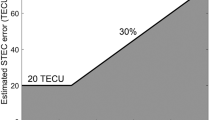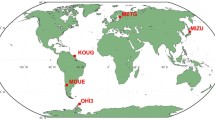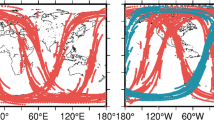Abstract
Europe’s Global Navigation Satellite System (GNSS) Galileo broadcasts three parameters for ionospheric correction as part of satellite navigation messages. They are called effective ionization coefficients and are used to drive the NeQuickG model in single frequency Galileo operations. The NeQuickG is a three-dimensional electron density model based on several Epstein layers whose anchor points, such as ionospheric peak densities and heights, are derived using the spatial and temporal interpolation of numerous global maps. This makes the NeQuickG computationally more expensive when compared with the GPS equivalent, the Klobuchar model. We propose here an alternative ionospheric correction approach for single frequency Galileo users. In the proposed approach, the broadcast coefficients are used to drive another ionospheric model called the Neustrelitz Total Electron Content Model (NTCM) instead of the NeQuickG. The proposed NTCM is driven by Galileo broadcast parameters and the investigation shows that it performs better than the NeQuickG when compared with the reference vertical total electron content (VTEC) data. It is found that the root mean squares (RMS) and standard deviations (STD) of residuals are approx. 1.6 and 1.2 TECU (1 TECU = 1016 electrons/m2) less for the NTCM than the NeQuickG. A comparison with the slant TEC reference data shows that the STD, mean and RMS residuals are approx. 9.5, 0.6, 10.0 TECU for the NeQuickG whereas for the NTCM, they are 9.3, 2.5, 10.1 TECU respectively. A comparison with Jason-2 altimeter datasets reveals that the NTCM performs better than the NeQuickG with RMS/STD deviations of approx. 7.5/7.4 and 8.2/7.9 TECU respectively. The investigation shows that the Galileo broadcast messages can be effectively used for driving the NTCM.







Similar content being viewed by others
Explore related subjects
Discover the latest articles, news and stories from top researchers in related subjects.References
Dow JM, Neilan RE, Rizos C (2009) The international GNSS service in a changing landscape of global navigation satellite systems. J Geodesy 83(3–4):191–198. https://doi.org/10.1007/s00190-008-0300-3
European Commission (2016) Galileo open service, ionospheric correction algorithm for Galileo single frequency receiver, issue 1, revision 2. https://www.gsc-europa.eu/system/files/galileo_documents/Galileo_Ionospheric_Model.pdf. Accessed 5 Mar 2017
Hochegger G, Nava B, Radicella SM, Leitinger R (2000) A family of ionospheric models for different uses. Phys Chem Earth Part C Solar Terr Planet Sci 25(4):307–310. https://doi.org/10.1016/S1464-1917(00)00022-2
Hoque MM, Jakowski N (2013) Mitigation of ionospheric mapping function error. In: Proceedings of ION GNSS 2013, Institute of Navigation, Nashville, Tennessee, USA, September 16–20, pp 1848–1855
Hoque MM, Jakowski N (2015) An alternative ionospheric correction model for global navigation satellite systems. J Geodesy 89(4):391–406. https://doi.org/10.1007/s00190-014-0783-z (ISSN 0949-7714)
Hoque MM, Jakowski N, Berdermann J (2017) Ionospheric correction using NTCM driven by GPS Klobuchar coefficients for GNSS applications. GPS Solut 21(4):1563–1572. https://doi.org/10.1007/s10291-017-0632-7
Hoque MM, Jakowski N, Berdermann J (2018) Positioning performance of the NTCM model driven by GPS Klobuchar model parameters. Space Weather Space Clim 8:A20. https://doi.org/10.1051/swsc/2018009
IS-GPS-200J (2018) Global positioning system directorate systems engineering and integration interface specification. Michael J D, Technical Director, Global Positioning Systems Directorate
Jakowski N, Hoque MM (2018) A new electron density model of the plasmasphere for operational applications and services. J Space Weather Space Clim 8:A16. https://doi.org/10.1051/swsc/2018002
Jakowski N, Hoque MM, Mayer C (2011a) A new global TEC model for estimating transionospheric radio wave propagation errors. J Geodesy 85(12):965–974. https://doi.org/10.1007/s00190-011-0455-1
Jakowski N, Mayer C, Hoque MM, Wilken V (2011b) TEC models and their use in ionosphere monitoring. Radio Sci 46:RS0D18. https://doi.org/10.1029/2010RS004620
Jones WB, Gallet RM (1962) The representation of diurnal and geographical variations of ionospheric data by numerical methods. ITU Telecommun J 29(5):129–149
Klobuchar JA (1987) Ionospheric time-delay algorithm for single frequency GPS users. IEEE Trans Aerosp Electron Syst AES 23(3):325–332. https://doi.org/10.1109/TAES.1987.310829
Nava B, Coisson P, Radicella SM (2008) A new version of the NeQuick ionosphere electron density model. J Atmos Terr Phys 70(15):1856–1862. https://doi.org/10.1016/j.jastp.2008.01.015
Orús-Pérez R (2018) Using tensor flow-based neural network to estimate GNSS single frequency ionospheric delay (IONONet). Adv Space Res 63(5):1607–1618. https://doi.org/10.1016/j.asr.2018.11.011
Orús-Pérez R, Hernández-Pajares M, Juan JM, Sanz J, García-Fernández M (2002) Performance of different TEC models to provide GPS ionospheric corrections. J Atmos Solar Terr Phys 64(18):2055–2062
Orús-Pérez R, Parro-Jimenez JM, Prieto-Cerdeira R (2018) Status of NeQuick G after the solar maximum of cycle 24. Radio Sci. https://doi.org/10.1002/2017RS006373
OS SIS ICD (2010) European GNSS Galileo open service signal in space interface control document, SISICD-2006, European Space Agency, Issue 1.1
Schaer S (1999) Mapping and predicting the earth’s ionosphere using the global positioning system. Geod.-Geophys. Arb. Schweiz, vol. 59, Eidg. Technische Hochschule Zürich
Schaer S, Beutler G, Rothacher M (1998) Mapping and predicting the ionosphere. In: Dow JM, Kouba J, Springer T (eds) Proceedings of the 1998 IGS analysis center workshop, Darmstadt, February 9–11. pp 307–318, ESA/ESOC, Darmstadt
Wu X, Hu X, Wang G, Zhong H, Tang C (2013) Evaluation of COMPASS ionospheric model in GNSS positioning. Adv Space Res 51(6):959–968
Acknowledgements
We would like to thank the sponsors and operators of NASA’s Earth Science Data Systems and the CDDIS for archiving and distributing the IGS data as well as all institutes and partners who took part in data capture and made the data available to the IGS. We thank the NOAA for making the Jason-2 data available to us via the National Center for Environmental Information. We are grateful to the ESA for providing historical data on the Galileo ionization coefficients broadcast in the 2013–2017 period.
Author information
Authors and Affiliations
Corresponding author
Additional information
Publisher’s Note
Springer Nature remains neutral with regard to jurisdictional claims in published maps and institutional affiliations.
Rights and permissions
About this article
Cite this article
Hoque, M.M., Jakowski, N. & Orús-Pérez, R. Fast ionospheric correction using Galileo Az coefficients and the NTCM model. GPS Solut 23, 41 (2019). https://doi.org/10.1007/s10291-019-0833-3
Received:
Accepted:
Published:
DOI: https://doi.org/10.1007/s10291-019-0833-3




